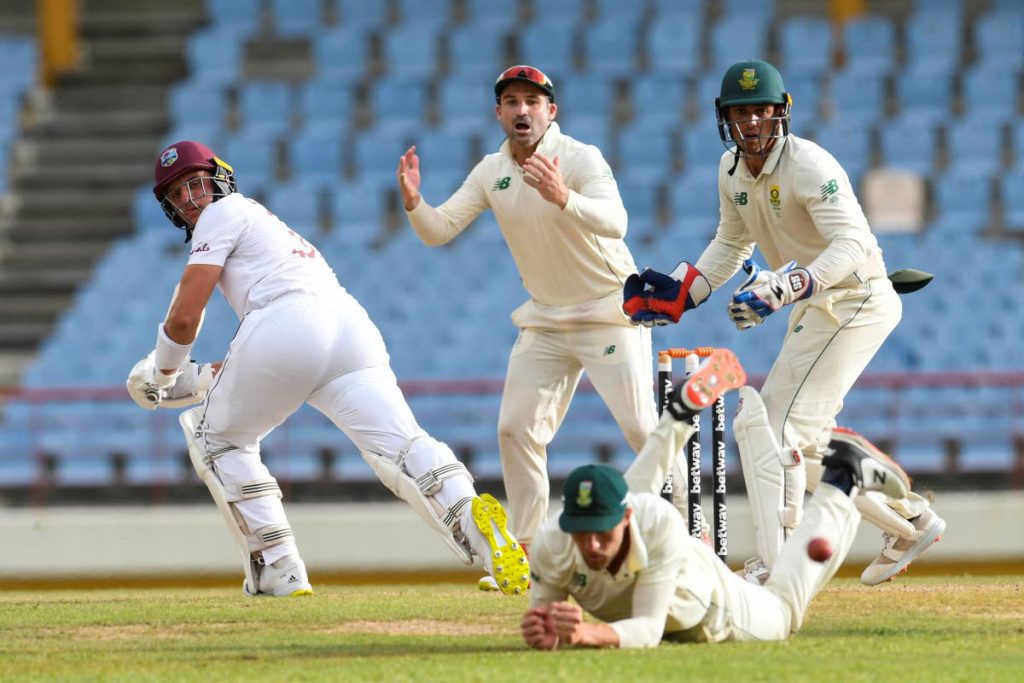The dominant South Africans

WEST INDIES (WI) are playing far below the strength of the South Africa (SA) team. One is therefore left to wonder how was it possible for WI to move up the table above SA.
Let’s face it, WI moved ahead of them to sixth position, leaving them in seventh. WI’s upward movement was due to their phenomenal, surprising performance against Bangladesh at the beginning of the year and their comforting drawn series against Sri Lanka after that.
Now, the chickens have come home to roost. In the first Test match of this two-match Test series, Kraigg Brathwaite, WI captain, won the toss and decided to bat first.
The pitch, as it turned out, had a generous distribution of moisture, yet not unlike first-day pitches for Test cricket. Nonetheless, WI batsmen couldn’t cope with the movement off the seam plus the swing that the visiting fast bowlers achieved. They were bundled out for 97.
Winning the toss a second time – a toss I feel he would have preferred to lose – his technically weak batsmen at the back of his mind plus his shattered confidence after losing the first Test by an innings, he decided to field first.
He reckoned he would give his critics a lesson – test the South Africans on a wicket fresh with preparation moisture, add another fast bowler in Shannon Gabriel, making it four by leaving out Rahkeem Cornwall, the off-spinner.
Off to a good start, WI bowlers had their opponents struggling. They were 37 for 3. But the tenacity of SA’s captain Dean Elgar held them together. Then in-form left-handed batsman, Quinton De Kock played a quality hand of 96 which took the initiative away from the WI’s bowlers.
The bowling lacked discipline and SA were let off the hook. The bowlers, except for Kyle Mayers, drifted off target, erratic and loose, and the extras accumulated to 42, including 12 wides, in a Test match on a helpful pitch. After they lost some play because of bad weather, the day closed at 218 for 5 wickets, an excellent recovery by SA. Quinton De Kock, the left-handed batsman/wicketkeeper who scored an undefeated century in the first Test, was on 59 and the skipper scored a solid 77.
It was a lesson in fortitude and determination, showing the character that cricketers must possess to succeed at the highest level.
At this time Brathwaite must have been having thoughts that the wicket would lose most of its moisture content the following day so that his batsmen would then be in a position to settle in and build a decent score. Firstly, his quickies would have to plough through the tail of the South African innings. Then his batsmen could take advantage of batting second on a less testing pitch.

But Brathwaite, when asked whether he chose to field because of the collapse in the first Test when he batted first, denied this was the reason.
His explanation? Because of the rainy conditions and the cloud cover.
Nevertheless, whatever his reasons, they just did not work.
The main cause of the WI collapse to exactly half the Proteas’ score, 149 to 298, was the faultless bowling of their opponents in addition to the dearth of batting technique required to combat the unrelenting movement of the ball at a troublesome pace.
There are no excuses for batsmen unable to play on different types of surfaces – certainly not in Test cricket.
So although the wickets were slow turners in Bangladesh, WI batsmen adjusted well to playing on it. And I praised them for it. Then, against Sri Lanka in Antigua, the wickets were flat and innocuous; they posed no problems.
In St Lucia, the wickets are bouncier, quicker, plus with some grass and more moisture content, they served the fast and medium bowlers with their movement off the seam. On pitches such as these batsmen can’t get away with a loose defence.
The only way for one to absorb the right technique to engage bowlers is to spend long hours in the nets practising. This means batting for hours on end. There were oodles of time for sessions after losing the first Test in two days and a session. There were five and a half days to prepare. Practice makes perfect.
More disciplined bowling in the second innings had SA reeling at 73/7 with the in-form De Kock zero, but they were let off the hook. Now, they’re left with 324 to win.
(
This week’s On the Front Foot column was written before South Africa won the Test series 2-0 on Monday.)


Comments
"The dominant South Africans"